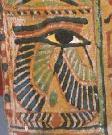Solar Symbolism
Solar Symbolism, Ancient and Modern
 The Sun Icon
The Sun Icon
There is a common astrological, and now astronomical, symbol for
the Sun. It's a circle with a dot in it. This particular image
was once the alchemical symbol for gold, being "...the most perfect
of the metals. For the alchemist, it represented the perfection
of all matter on any level, including that of the mind, spirit, and soul."
The symbol's association with both gold and the Sun evidently
dates back as far as alchemy does. The article
Gold and the Sun
mentions that aurum the latin word for gold, is derived from
the Greek name Aurora, the goddess of the dawn. So the color of gold
was associated with the brilliance of the Sun since ancient times.
Another site, Alchemy and
Symbols,
notes that "Only a few metals were known to the alchemists. They were,
namely, gold, silver, iron, mercury, tin, copper and lead. Since they
knew only seven planets [sic - should be 6 planets plus the Sun]
and seven gods, they named these
seven metals after the gods of the planets. These metals then, were known as
the "Seven Metals of the Ancients." Gold, the noble metal, was named
after Sol, the golden Sun whose symbol was the perfect sphere;..." and
later, "The seven metals were each assigned a day in the week; thus,
Sunday was gold (Sol)...".
One site notes that "A dot or point in the center of a
circle symbolizes the blending of male and female forces.
Hindus call the midpoint in a circle the bindu - the spark of
(masculine) life within the cosmic womb. However,
how that relates to the Sun is not explained.
 The Winged Eye
The Winged Eye
There are some intriguing interpretations of the ancient
Egyptian winged eye symbol and the Aztec "Eye of God" symbol
as representing the coronas seen during total solar eclipses.
You might also check out the
An Aztec "Eye of God" Symbol and animation.
 The Solar Cross
The Solar Cross
The commonly seen solar "cross" symbol is generally understood
as representing the cyclical nature of the seasons:
The
Cross Symbol.
 The Face in the Sun
The Face in the Sun
It appears that the Sun was worshipped as a personified, life-giving
deity in Babylonian, Egyptian, Greek, Roman, and other major
civilizations of history. For a culture who viewed the Sun as
a god, it was not a far next step to feature their
god with a face, such as the common symbol face in
the center of the Sun's rays.
At least one website features a Sun face that was said to
be part of an 18th century Masonic ritual painting, and that it
illustrated a symbol that has been central to most
major spiritual systems of history. "Since the Sun god usually reigned
over a pantheon of lesser gods. his symbol played a vital part in pagan
worship (and in the rituals of occult secret societies) around the
world. In Inca myths, the Sun was worshipped as the divine ancestor of
the nation." For more on Masonic symbolism, see
Various Masonic Symbols.
 Zia Symbol
Zia Symbol
The Zia Indians of New Mexico regard the Sun as a sacred symbol.
Their symbol, a red circle with groups of rays pointing in four directions,
is painted on ceremonial vases, drawn on the ground
around campfires, and used to introduce newborns to the Sun.
Four is the sacred number of the Zia and can be found repeated in the
four points radiating from the circle. The number four is embodied in
the four points of the of the compass, north, south, east, and west; in
the four seasons of the year spring, summer, autumn and winter; in the
24 hours of each day by sunrise, noon, evening and night; by four
seasons of life, childhood, youth, adulthood and old age. The Zia also
believe that with life come four sacred obligations: development of a
strong body, a clear mind, a pure spirit and devotion to the welfare of
people/family. All of these are bound together within the circle
of life.
The Zia Sun symbol also adorns the New Mexico state flag,
the governor's stationery and the yellow pages,
peddling items from pest control to portable toilets. In 1999, the Zias and other
tribes looked to the U.S. Patent and Trademark Office to stop
commercial exploitation of their sacred symbols.
See also
The New Mexico State Flag.
Please note that some of the websites mentioned above are sponsored
by various religions of one form or another and may
be seeing the symbolism from their own point of view.
Image Credits:
| |

